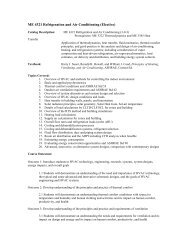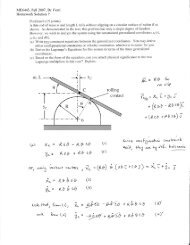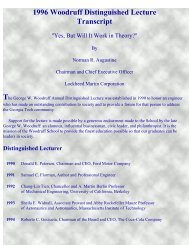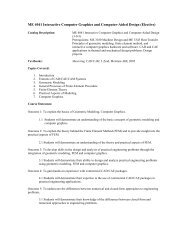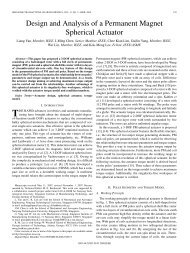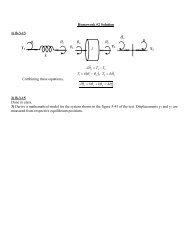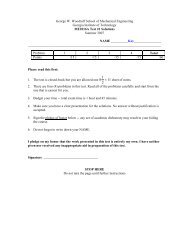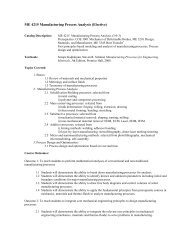Homework Assignment 3
Homework Assignment 3
Homework Assignment 3
Create successful ePaper yourself
Turn your PDF publications into a flip-book with our unique Google optimized e-Paper software.
ME6758, Fall 2005, Dr. Ferri<strong>Homework</strong> <strong>Assignment</strong> 3Due Weds, Sept. 14, 2005Problem 1. (4 points)The natural frequencies of vibration (in Hz) for a cantilevered beam of length L, elastic modulusE, density ρ, cross-sectional area A, and cross-sectional area moment I is given by:pnEIfn=π L2 n= 1, 2, … ∞2 ρAwhere p n is the nth root of the equationcosh( x )cos( x)+ 1 = 02(a) Plot the functions cos(x) and -1/cosh(x) on the same graph and identify the first 5 crossingpointsof the curves (for x > 0).(b) Find the first 3 natural frequencies of a thin steel ruler with 2-inches clamped to a sturdytable. Use the following geometric and material properties: L = 0.25 m, E = 200e9 N/m2, I =1.667e-12 m4 , ρ = 7800 kg/m3, and A = 2e-5m2. Clearly state: (1) the root-solvingalgorithm that you are using to obtain pn, (2) the starting guess(es) or initial search interval,and (3) the convergence criterion (e.g., the tolerance or percent error in successiveapproximations, etc.)(c) Due to the behavior of sinh and cosh for large arguments, it is very desirable to find anapproximate expression for the higher natural frequencies. Based on the nature of the plot inpart (a), give an asymptotic expression for fn that applies for large n. What is the percenterror between the approximate value (based on the asymptotic approximation) and the valuethat you computed in part (b) for the third natural frequency?Problem 2. (3 points)(a) On the same plot, graph the four (4) Lagrange polynomials L3,0, L3,1, L3,2, and L3,3associated with the 4 points x0 = 1, x1 = 2, x2 = 3, and x3 = 4.(b) Use the 4 Lagrange polynomials from part (a) to approximate the function f(x) =1/(1+x2);i.e., generate the interpolating polynomial P3(x). Examine the qualitative agreementbetween P3 (x) and f(x) by plotting both functions from x=0 to x=5 using a fine spacing ofx-values.(c) Use P3 (x) from part (b) to find the interpolated value of f(x) at a value of x = 1.5. Calculatethe percent error in the interpolated value compared with f(1.5).Problem 3. (3 points)Use Newton’s Interpolatory Divided-Difference Formula to generate a 3rd-order interpolatingpolynomial for the function f(x) =1/(1+x2).
(a) Create a table similar to Table 3.8 in the text using the initial data points: (-1,0.5), (0,1),(1,0.5), and (2,0.2).(b) Use the result from part (a) to interpolate the value of the function at x = 1.5. Give both thevalue you obtained and the percent error relative to the exact value.



